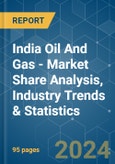The India Oil And Gas Market size is estimated at 38.12 Billion cubic meter in 2024, and is expected to reach 49.12 Billion cubic meter by 2029, growing at a CAGR of 5.20% during the forecast period (2024-2029).
The market was negatively impacted by the outbreak of COVID-19 due to regional lockdowns and a decline in demand for refined petroleum products. Currently, the market has rebounded to pre-pandemic levels.
This product will be delivered within 2 business days.
The market was negatively impacted by the outbreak of COVID-19 due to regional lockdowns and a decline in demand for refined petroleum products. Currently, the market has rebounded to pre-pandemic levels.
Key Highlights
- Factors such as the increasing natural gas pipeline capacity and the increasing demand for petroleum products are expected to drive the Indian oil and gas market during the forecast period. Also, the oil and natural gas market is a major industry in the energy market and plays an influential role in the global economy as the world's primary fuel source. The processes and systems involved in producing and distributing oil and gas are highly complex, capital-intensive, and require state-of-the-art technology.
- However, a huge dependence on imports of crude oil and natural gas to satisfy domestic demand and the high volatility of crude oil prices are expected to hinder the growth of the Indian oil and gas market.
- There have been significant gas hydrate discoveries in the KG Basin. Economically feasible extraction of the gas hydrates may create immense opportunities for the companies, which may lead to a boom in natural gas production.
India Oil and Gas Market Trends
The Downstream Sector is Expected to Witness Significant Growth
- Indian energy demand is anticipated to grow by 50% in the next two decades. This growth in demand can be attributed to the growing world population and an improvement in living standards in developing countries. Even though new and renewable energy sources are gaining popularity around the world, petroleum fuel remains a major energy source globally. This trend is expected to continue for the next few decades and favors the growth of the oil and gas downstream market.
- New refineries were set to be established in various parts of the country. For instance, in February 2023, Hindustan Petroleum Corp (HPCL) announced that the company plans to start its 9 million tonne-a-year Barmer refinery and petrochemical project in Rajasthan state by January 2024.
- The country's oil refinery throughput in the fiscal year (2021-2022) was 249.22 million metric tons, a growth from the 2017 figures, which were around 233.97 million metric tons. The increased value is the conclusion of the high demand for transport fuels like motor gasoline and diesel and the constantly high demand for LPG in the market's residential segment.
- The other major factor that has led to the requirement of high refining capacity is the increasing number of fields in the country, especially in the Krishna-Godavari Basin and Barmer Region of Rajasthan State. The high natural gas production from these fields has led to an expansion in the capacity of refineries and petrochemical complexes in the country.
- Owing to several major upcoming projects, the downstream sector is expected to witness significant growth during the forecast period.
Increasing Investment in the Midstream Sector May Drive the Market
- The pipeline is the most economical way of transporting natural gas, crude oil, and petroleum products over a long distance due to increasing investments in upcoming pipelines in the country. The midstream segment is expected to contribute a decent share in the Indian oil and gas market in the coming years.
- As of March 2022, the country had around 10,419 km of crude oil pipelines (onshore: 9,825 km and offshore: 594 km), 17,389 km of natural gas pipelines (onshore: 17,365 km and offshore: 24 km), and 14,729 km of refined products pipelines, being operated by IOCL, BORL, Cairn India, OIL, HMEL, and ONGC. In addition to the pipelines, India had 5 LNG terminals in March 2022.
- In February 2022, the government of India announced to double its exploration area of oil and gas to 0.5 million sq. km. by 2025 and to 1 million sq. km. by 2030 with a view to increasing domestic output.
- As of June 30, 2022, the Gas Authority of India Ltd (GAIL) had the largest share of the country's natural gas pipeline network, i.e., 33,815 km.
- As of 2022, Indian Oil Corporation accounted for 50.88% (15113 km) of India's crude pipeline network. The Indian government is set to invest USD 9.97 billion to expand the gas pipeline network across the country, culminating in the growth of the market.
- In March 2022, Indian Oil Corporation (IOC) Limited approved to invest USD 932.6 million for the development of City Gas Distribution (CGD) network in 9 geographical areas.
- Hence, increasing investments in the midstream sector have driven the India oil and gas market. Pipeline coverage is expected to increase substantially during the forecast period, with the petroleum product pipeline expected to increase the most in the segment.
India Oil and Gas Industry Overview
The India oil and gas market is fragmanted. Some of the key players (in no particular order) include Oil and Natural Gas Corporation (ONGC), Oil India Limited (OIL), Reliance Industries, Indian Oil Corporation Limited (IOCL), and Punj Lloyd Limited., among others.Additional Benefits:
- The market estimate (ME) sheet in Excel format
- 3 months of analyst support
This product will be delivered within 2 business days.
Table of Contents
1 INTRODUCTION
4 MARKET OVERVIEW
5 MARKET SEGMENTATION
6 COMPETITIVE LANDSCAPE
Companies Mentioned (Partial List)
A selection of companies mentioned in this report includes, but is not limited to:
- Oil and Natural Gas Corporation
- Oil India Limited
- Reliance Industries
- Indian Oil Corporation Limited
- Punj Lloyd Limited
- Bharat Petroleum Corporation Limited
- GAIL (India) Limited
- Hindustan Petroleum Corporation Limited
- Cairn India
Methodology

LOADING...










